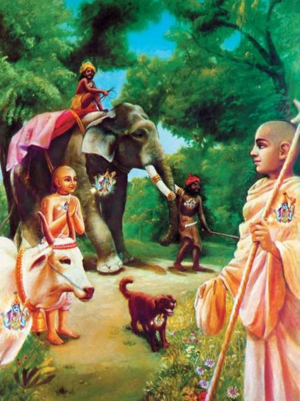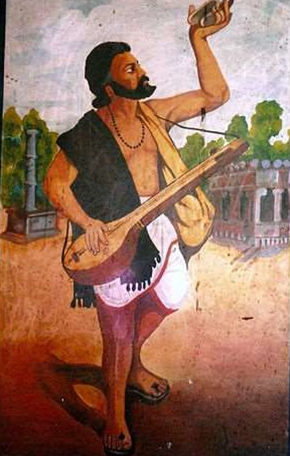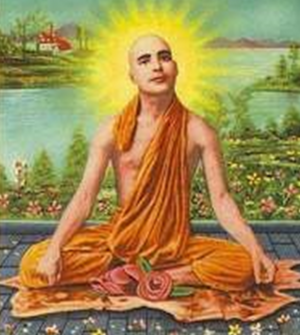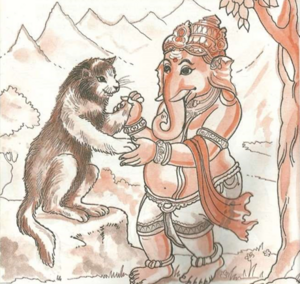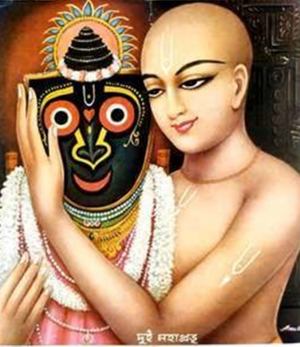Talk:Attributes of Saguṇa Brahman as Antaryāmin
By Sri Vishal Agarwal
The concept of Antaryāmī (inner controller) is explained in several stages. As the immanent ātmā, Brahman is described as the unifying principle of the universe, the controller of beings from within, the true agent of cosmic and bodily processes, and the witness (sākṣī) of all actions.
1. Underlying Unity
As the Antaryāmī, Brahman provides an underlying unity to the entire creation, holding it together as a single whole.
2. Controller of Beings
Brahman is also described as the indwelling controller of all creatures:
The ātmā, who resides within the hearts of all, is the ruler of all. Yajurveda, Taittirīya Āraṇyaka 3.11.2
Īśvara resides in the hearts of all beings, causing them to turn around by His māyā as if they were mounted on a machine. Gītā 18.61
3. The True Agent of All Processes
Brahman is presented as the directing agent of natural and cosmic functions:
By whom, willed and directed, does the mind shine on its objects? By whom, commanded, does prāṇa show activity? At whose will do people utter words? And what Divine is it that prompts the eye and the ear? Because it is that (Brahman) which is the ear of the ear, the mind of the mind, the speech of the speech, the breath of the breath, the eye of the eye – the wise, after giving up wrong notions of self-sufficiency and after their death, become immortal. Sāmaveda, Kena Upaniṣad 1.1–2
The brilliance which emerges from the sun, illuminating the entire universe, which is in the moon and which is in the fire—know that brilliance to be Mine. Gītā 15.12
Permeating the earth, I support all beings with vitality, and having become the soma (moon) full of sap, I nourish all the plants. Gītā 15.13
Having become Vaiśvānara, residing within the bodies of all creatures, and combining with the prāṇa and apāna, I digest the four kinds of food. Gītā 15.14[1]
And I am lodged within the hearts of all. From Me come memory and knowledge as well as their loss. I indeed am that which is to be known by all the Vedas. I am author (fulfiller) of the Vedānta and the knower of the Vedas. Gītā 15.15
Illustration: The Main Switch and the Secondary Switch
A contemporary analogy compares the role of Brahman to a power system. Brahman is like the main switch, while individual beings are like smaller downstream switches. If the main switch is off, the smaller ones cannot function regardless of their position. This illustrates that all activity depends ultimately on the divine source.[2]
Story: Kṛṣṇa as Protector of the Pāṇḍava-s
According to the Mahābhārata, after the war, the Pāṇḍava-s and Kṛṣṇa entered the Kaurava camp to take possession of the treasury, symbolizing their security. When Arjuna stepped off his chariot at Kṛṣṇa’s request, Hanumān disappeared from the flag, and soon after, the chariot burst into flames. Kṛṣṇa explained that the chariot had absorbed many destructive weapons during the war and should have been destroyed earlier, but His presence preserved it. Once the war was over, that protection was no longer necessary. The incident illustrated that their survival and victory depended upon divine presence.
4. Brahman as Witness (Sākṣī)
As the indwelling witness, Brahman is described as overseeing actions without being tainted by them, while also dispensing the fruits of karm.
I know the past and the present as also the future beings, but no one knows Me! Gītā 7.26
The one Deva, hidden in all beings, all-pervading, the inner ātmā of all beings, the overseer of all karm, who dwells in all beings, the witness, the knower, the only one who is not tainted by the guṇa-s. Yajurveda, Śvetāśvatara Upaniṣad 6.11
The fruit of karm comes from Brahman, because that possibility alone is the logical one. Brahmasūtra 3.2.38
The witness and permitter, sustainer, experiencer, the great Bhagavān, the Supreme Ātmā thus is also called the Supreme Puruṣa inside this body. Gītā 13.22
Īśvara, the Dispenser, is the one who gives happiness and sorrows, and what is dear and what is not dear to all creatures on the basis of their past karmas. Īśvara indeed is the Master of everyone. Mahābhārata 3.30.22
Just as space is all-pervading, Īśvara too pervades all creatures as a witness and determines their measure of happiness and sorrows depending on their karmas. Mahābhārata 3.30.24
Vedāntic texts emphasize that nothing is hidden from the divine witness, who is all-pervading and present throughout creation, ensuring that each being receives the appropriate result of its karm.
Story: Kanakadāsa and the Divine Witness
Kanakadāsa (1509–1609 CE), a poet-saint and disciple of Vyāsatīrtha, became famous for his devotion to Viṣṇu despite his humble origins. According to tradition, Vyāsatīrtha once gave his students bananas, instructing them to eat in a place where no one could see them. While the others returned after completing the task, Kanakadāsa did not. When asked why, he replied, I could not find a place where Bhagavān could not see me.
This incident was cited by Vyāsatīrtha to illustrate Kanakadāsa’s deep realization of the all-pervading presence of the divine witness.
5. Presence in the Heart, Meditation, and Mokṣa
This teaching does not imply that Brahman is present only in the hearts of creatures or absent in beings without a physical heart. Rather, the heart is emphasized as a particularly fruitful locus for meditation.
Kṛṣṇa said to Arjuna: I am the Soul seated in the hearts of all creatures. I am the beginning, the middle, and the very end of beings. Gītā 10.20
In deep meditation, the individual soul is described as abiding in the heart (dahara-puṇḍarīka), in close communion with Brahman.
6. All Beings as Abodes of the Divine and the Ethic of Equal Regard
The presence of Brahman as Antaryāmī in all beings implies that all living creatures are worthy of respect. The texts emphasize impartiality and equality of vision:
Kṛṣṇa said to Arjuna: Sages see the same (Brahman) in a brāhmaṇa imbued with learning and humility, in a cow, an elephant, or even a dog or an outcaste. Gītā 5.18
I am the same Soul in all. None is hateful or dear to Me. But those who worship Me with devotion, they are in Me and I am also in them. Gītā 9.29
He who perceives the Supreme Bhagavān as abiding alike in all beings, not perishing when they perish—he truly sees. Gītā 13.27
Perceiving the same Bhagavān as established alike everywhere, he does not hurt the ātmā by the ātmā. Then, he attains the supreme goal. Gītā 13.28
None is dear to You, none inimical, none indifferent. These differences are only attributed to You by them whose vision is clouded by māyā. Svayamprabhā in Adhyātma Rāmāyaṇa Rāmāyaṇa 4.6.71
The texts attribute differences in experience and status to prior actions (karm), not to divine partiality. They teach equal regard irrespective of gender, ethnicity, national origin, or religion, and encourage recognition of the common divinity in all.
He excels, who regards equally well-wisher, friend, enemy, neutral, mediators, despicable persons, and kinsmen, and even the virtuous and the evil. Gītā 6.9
He who is disciplined by yog sees his ātmā present in all beings, and all beings present in the ātmā, regarding all everywhere as the same. Gītā 6.29
He who sees Me everywhere, and sees all things in Me, I am not lost to him and he is not lost to Me. Gītā 6.30
The yogī who, established in Unity, worships Me as abiding in all beings, lives in Me in whatever way he otherwise acts. Gītā 6.31
Arjuna, he who sees equally everywhere, and regards all others as if they were his own ātmā, whether in pleasure or in pain, he is considered to be the perfect yogī. Gītā 6.32
That one, who is able to visualize the presence of ātmā in all other moving things and creatures, and is able to visualize the presence of all such things within the ātmā, never gets angry and never hates anything in life. Īśāvāsya Upaniṣad 6
When he has identified the unison between all moving things (including creatures) and the ātmā, where is the question of him getting into delusion or sorrow? Īśāvāsya Upaniṣad 7
Illustration: The Main Switch and the Secondary Switch A contemporary analogy presents Brahman as the main power switch and individuals as downstream switches. If the main switch is off, no appliance functions, illustrating dependence on the ultimate source for all activity.[3]
Story: Svāmī Rāmatīrtha (1873–1906 CE) and the Path to Happiness
Svāmī Rāmatīrtha, born in Murāriwālā (present-day Pakistan), became a mathematics teacher in Lahore and later a sannyāsī after hearing Svāmī Vivekānanda. During his lectures on Vedānta in the United States (1902–1904), a bereaved mother sought peace. The Svāmī proposed a “price”: he brought an African-American child and suggested she raise him as her own to find lasting happiness. When she hesitated, he explained that true peace arises from overcoming discrimination and recognizing the divine presence in all. The gesture “Namaste” is presented as acknowledging the divine in others, and the Bṛhadāraṇyaka Upaniṣad dialogue of Yājñavalkya and Maitreyī is cited to ground universal love in the unity of Brahman.
Story: Gaṇeśa Learns from Pārvatī
Gaṇeśa, playing on Kailāśa, tried to make a cat dance upright and, frustrated, scratched it. Later, Pārvatī revealed wounds on her face. When Gaṇeśa protested, she asked if he had scratched anyone. On his admitting he had scratched a cat, Pārvatī explained that as Mother of the universe she dwells in every creature; harming another is thus harming her. Gaṇeśa resolved not to hurt others, concluding that pleasing Bhagavān consists in loving all beings.
Story: The Divine in the Beautiful and the “Ugly”
A king of Kaliṅga commissioned a mūrti of Viṣṇu with a severe condition. An elderly sculptor accepted on the condition that the temple doors remain closed for thirty days. On day twenty-one, the king opened the doors prematurely and found an unfinished, seemingly “ugly” image. The sculptor explained that Viṣṇu pervades the entire creation, including forms perceived as unattractive; the lesson was to worship the unfinished image and recognize divinity beyond aesthetic preferences. The account concludes with the king learning that beauty and ugliness are matters of perception, while Bhagavān is present in all forms.

